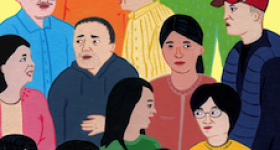IN THE TRAILER for Jonathan Demme's 2008 family drama, Rachel Getting Married, a white family prepares for an Indian-themed wedding. The tagline reads: "This is not your family. But this is your family."
It's a bold statement, one that acknowledges the universal theme of family dysfunction yet ignores the possibility that people of color may not find this family relatable (even if Anne Hathaway dons a sari). American cinematic families have traditionally been white, and the range of their experiences has been diverse enough to include the bitter divorcés of Kramer vs. Kramer as well as the fallen genius clan of The Royal Tenenbaums.
Such variety has been lacking with regard to Asian American families in film. Generational friction between immigrant parents and their American-born children - while a real phenomenon for many has become a repetitive trope, boxing in Asian American families as apparently incapable of experiencing other kinds of joys or frustrations. This prompts the question: So what else is new?
Where's the drug abuse? The neurosis? The general bitchiness and resentment between loved ones? They exist in real Asian American families, so why aren't they more often translated to film?
Indeed, while some filmmakers stick to the cinematic house that The Joy Luck Club built, others are digging deeper into family stories that tease out human commonalities yet still reflect the significance of Asian American culture.
Michael Kang, director of The Motel (2005), is one filmmaker presenting fresher insight into Asian American family life. "Assimilation as the central issue is irrelevant to me," Kang says. "I've always felt that the more internal struggle with personal identity is more universal as well as more compelling."
Adaptation to American life and intergenerational clashes are the most enduring themes in Asian American cinema, dating back to 1961 when the Wang children bemoaned their parents' old-school ways through pirouettes and musical numbers in Flower Drum Song. Fortunately, modern cinema also provides glimpses into the psyches of Asian immigrant parents - and the family dynamics they create with their children - which allow them to come alive as more than glowering, hard-ass clichés.
Mira Nair's Mississippi Masala (1991) depicts with nuance a displaced Indian couple's anger over their daughter's romance with an African American man against the terrible backdrop of flashbacks to Idi Amin's Uganda. In 2007, Nair again explores how the past affects relationships between parents and children in The Namesake, portraying tender Indian parents who overcome near-death and a transnational move to raise two children in America.
Some filmmakers are tackling the coming-of-age theme and including Asian American characters in the awkward pubescent mix. The Motel, adapted from Ed Lin's novel Waylaid, follows a Chinese American teen who, while growing up in a seedy motel, deals with a raging libido, a weight problem and an irritable single mother. His desolate locale is a far cry from the middle-class suburbs or urban ethnic enclaves in which Asian American families are typically portrayed.
"I try to tell stories that I don't normally get to see. By showing the disparity in classes within the Asian American community, I hope that I am able to shed light on a bigger issue of socioeconomic problems in the world," Kang says. "The setting for The Motel was intriguing to me on many levels. A dirty motel is probably the worst place to be going through puberty. There was also something very American in the pioneering spirit of the Chin family going to this unchartered land and struggling to make it."
A similar pioneering spirit is weaving through the cinema as filmmakers develop new representations of families, both biological and surrogate, both homogenous and ethnically mixed. In the recent past we've seen Vietnamese orphans adopted into an African American family (Catfish in Black Bean Sauce, 1999), a Chinese American lesbian and her pregnant single mother (Saving Face, 2004), and the all-American Nomura family interned during World War Il (American Pastime, 2007).
But such developments reflect a tough climb, considering the tepid reception of Asian American films in the movie industry. "I think it will be a while before we reach the tipping point where Asian Americans can tell Asian American stories that are accepted by mainstream authences," Kang says.
It may be a while before the Rachel who's getting married is Asian American. But if cinema continues to make cultural progress, one day everyone in the authence will be able to say, unequivocally, "Now this is my family."
Writer Sylvie Kim
Sylvie Kim is Hyphen's film editor. She only moderately disappoints her mother.










Comments